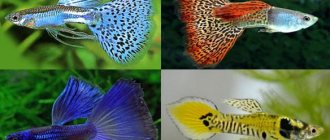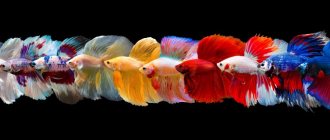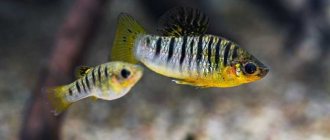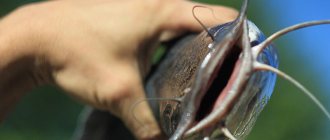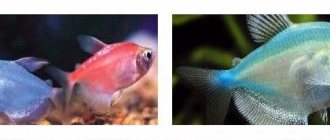Aquarists have kept guppies in aquariums for over 100 years. Since then, many species of guppies have been studied and new breeds have been developed, and international exhibitions have been held. It is easy to get confused in the variety of breeds, so a classification was adopted according to the predominant color, shape of the tail and fins.
Varieties of guppies by color
Many colors have been released. Often, when talking about yellow or blue guppies, they mean several similar breeds.
Reds
- Red Moscow. Guppies are intense red in color. The front part of the abdomen and muzzle are light.
- Red cobra (filigree). The fins are red, the body of the fish is paler. There is an iridescent pattern that resembles snake skin.
- Red clove. Rich red fish.
- Tomato. The color is completely bright red.
- Red dragon (royal). The fish is intense red in color. There are dark or light blotches on the body.
- Red blond. The color is scarlet with turquoise, yellow or light splashes.
Orange
- Orange carpets. The scales and veil are decorated with a dark pattern reminiscent of a mosaic. The main color of the fish is orange.
- Carnation. The guppy's body has white, dark and orange tones. The tail “skirt” is brick-red with several vertical rows of black dots.
Yellow
- Yellow carpets. A yellow variety of carpet-patterned guppy.
- Germanic. The color is yellow, they come with a completely or half white body.
- Golden (golden). A fish with yellowish scales that shimmer golden in the light.
- Yellow blond. The color is intense yellow with white splashes.
Greens
- Moscow blue-greens. The body is turquoise, sometimes with olive spots on the back and muzzle. The scales shimmer blue and green.
- Green cobra. The main color is yellow-green, the “skirt” has a motley pattern.
- Smaragdaceae (emerald). There are mosaic patterns on the green body of the fish.
Blue and light blue
- Japanese. The body is dark, all veil parts are turquoise-bluish.
- Blue carpets. Blue fish with a wonderful pattern of dark dots.
- Moscow blues. Rich blue color is combined with light and purple splashes.
- Blue glass. The color is gray with the addition of blue and greenish spots; the “skirt” has a blue edging.
- Japanese blond. The color of the fish is pearlescent blue. The tail shape of this species is “double sword”.
- Metallic blue. The veils of the fish are deep blue with blue splashes, the body is gray-blue.
Black
- Black Prince. In the area of the head and front part the abdomen is silvery, the tail and the second part of the body are black. The transition between colors is smooth.
- Black monk (black Moscow) individuals are completely black or with a small light spot near the head. Body with a bluish tint. Medium and small fish are more intensely colored.
- Tuxedo (tuxedo). The front part of the body is light, the tail part is black. Red, yellow or green shades may be present. The transition between black and white is clear.
- Panda. The front part of the abdomen is light, the upper part of the head, eyes and fins are black, which makes the fish look like a panda.
White
- Semi-black white (white prince). Mainly white in color, the second part of the body is dark. The veil “skirt” of the fish is snow-white.
- Pearlescent white. White scales with a pearlescent tint. There are fish with darkening in the muzzle area.
- Albino. The eyes are reddish, the color is completely white.
- Blond. White variety with dark eyes.
Leopard
Dark spots on a yellow background make the fish's scales look like animal skin.
Neon
Neons are distinguished by their bright tint and rich colors. There are neon varieties of guppies:
- blue;
- green;
- red;
- violet.
Diseases
Signs of illness that require a reaction:
- cloudy or black eyes - may be a feature of coloring, condition after childbirth, or a sign of mycobacteriosis. The fish's back bends and its belly becomes sunken. This disease is incurable;
- white voluminous spots on the fins and body - ichthyophthyriasis;
- lethargy and lying on the bottom – ichthyosporidosis;
- yellowish coating on the scales – oodinosis;
- frayed, faded fins with cloudy edges – fin rot;
- bright red coating on the tail - “red scab”.
Guppy diseases are treated with antibiotics of the tetracycline group, methylene blue, bicillin or salted water.
Prevention of diseases consists of observing temperature conditions and hygiene rules for equipment for cleaning the aquarium, properly selected food and introducing only proven newcomers who have undergone quarantine. Terminally ill fish should be removed from the aquarium immediately.
Classification according to the shape of the tail and fins
Guppy breeds are also classified by the shape of their fins. Often the forms are similar to each other. There are 14 forms.
Fantails
The tail is large and wide without sharp ends. The veil on the back is directed downwards.
Fork
Tail with 2 sharp ends. The narrow dorsal fin is located parallel to the body.
Flagtails
The guppy's "skirt" is rectangular with a smooth edge. The dorsal plumage is directed upward, pointed at the end.
Spinetails
The guppy's "fan" is rounded, with "needles" in the center. The dorsal fin is raised and pointed at the end, its length occupies a third of the entire body.
Speartails
The tail resembles the point of a spear, less rounded than in spiny tails and with a smoother transition to pointed central rays. The length of the tail is equal to half the body. The plumage on the back is curved and pointed.
Triangel
Another name for the variety: clipped fantail. The triangular “fan” does not have such a strong swing as that of fan-tailed guppies. The corners are clear and sharp. The fin on the back is wide, raised, ending at the level of a third of the tail.
Round-tailed
The caudal fin is rounded and miniature, the dorsal fin is rounded and shortened. The size of the tail is no more than half the body of the fish.
Double sword
Rounded tail with long outer rays. The guppy has a narrow, elongated fin on its back.
Lyrebirds
The shape of the “skirt” is similar to a lyre. The short dorsal fin is directed upward.
Lower sword
The “skirt” is rounded, with a sword-shaped appendage at the bottom. The plumage of the back is narrow and pointed.
Upper sword
The “sword” is located on top, unlike the previous variety of guppy.
Spadetails
The tail is large, square, and rounded; its length is equal to half the body of the fish. The dorsal plumage is long.
Sharp-tailed fantails
Lush triangular “skirt”. The fin on the back is directed upward.
Veil-tailed skirts
The fins are elongated, not too wide, the dorsal is directed upward.
Other types
- Sunset. The color is dominated by the colors characteristic of the evening sky: yellow and red.
- Galaxy is a fish with a scattering of black dots on a multi-colored background.
- Martin. The guppy's tail has elongated rays, which makes it look “ragged.”
- Red multicolor carnation. Variegated plumage of a brick shade with a black pattern.
- Berlin. The guppy's fins are scarlet, and the body has orange, silver and gray tones.
Compatibility with other fish
Guppies are not known for their aggressive nature, so they cannot be housed with all types of fish. The best neighbors will be small, non-conflicting fish. Guppies can be kept together with:
- cockroach;
- corridors;
- neon;
- tetras;
- zebrafish;
- boots;
- iris;
- gourami;
- cockerels, etc.
Placing guppies with pangasius, gouramis and other large predatory species will result in the small representatives of the aquarium fauna being quickly eaten. Barbs and some other species can bite the large fins of males. In addition, it is unacceptable to combine guppies with aggressive cyclids.
(FAQ)
Recommendations for keeping guppies
So, it is advisable, even before you get ready to get guppies, read at least something about them! To begin with, I will note that:
- Guppies live in home aquariums from 2 to 5 years (depending on the conditions of detention),
- preferring a relatively old one (with changes up to 1/5 of the volume weekly) and
- slightly salted water (at least
1 tablespoon salt per bucket
| Genotype - a set of genes that one has to guess about by observing phenotype - a set of external characteristics determined by |
Features of behavior
Guppies are peaceful creatures that do not harm their neighbors. But they also cannot defend themselves, so you need to add fish of the same nature to them: swordtails, platies, cardinals, neons, rasboras, etc.
Guppies look good in a monospecies aquarium. In this case, they reproduce easily, do not experience stress, eat enough and feel comfortable.
Guppies swim throughout the entire thickness of the water, sinking to the bottom or rising to the surface. These are playful fish, they like to swim after each other, but they can also retire for a while to gain strength.
About commerce and aesthetics in guppy breeding
This is the time to find out the commercial and aesthetic aspects of selection and/or mass breeding/keeping of guppies. As we will now find out, these are two quite different, although not completely opposite, directions.
Indeed, the requirements of most buyers, i.e. owners of home aquariums, simple and clear - you just need colorful and bright fish!
And most often this is not a “linear” fish at all, but on the contrary - the first or second generations of mixes of different breeds.
The best specimens from the mixes are sold individually through markets, and the remaining least successful specimens are sold in bulk to pet stores. Mixed breeds are usually naturally stronger, grow faster, and can more often reach large sizes.
breeders
breeding such commercial
fish (in large,
commercial
quantities) .
While the breeder
who supports a well-known (or is trying to breed a new) breed, the views are completely different: selected fish do not always have commercial qualities (for example, bright and durable fins on males).
But it is the breed
(especially
pure lines
) that is the initial breeding material for those first- and second-generation mixes that are usually of interest to the mass buyer, i.e. are of commercial interest. And therefore, the requirements for such “pro-commercial sources” are slightly different: the largest and most fertile females, a clear pattern (or vice versa, the density of solid color) and the correct shape of the fins, regular coloring of the body (i.e., without chaotic spots on the body) in males.
From these points of view (commercial and breeding) I will further present the breeds I have.
Reproduction
How to determine sex: females are larger, have a fuller abdomen, but the color is paler, there are no large fins and rich color transitions. Males are twice as small, but they attract lovers with their appearance. If reproduction is not planned at all, and the fish are kept for beauty, it is permissible to place only males in the biotope.
These are viviparous fish, the eggs mature in the female’s body, and larvae with a yolk sac are born, from where the new organism takes food for the first few days. Therefore, guppy breeding is considered simple. The birth of new fish can be observed even in a community aquarium. True, in this case only the strongest and most cunning individuals survive to adulthood. The rest are eaten.
Simple reproduction gives modest results: the fry are called mix, they do not represent breeding value and often lose color and degenerate. If you want the aquarium to be populated by truly luxurious representatives, it is better not to put different breeds in the same tank.
Selective propagation is a more labor-intensive process, and it begins with a strict selection of representatives for crossing. For one male there are 2-3 females. In this case, you need to comply with the conditions (for example, maintain a temperature of 24 °C), know the rules for culling offspring, and place the pregnant female in the spawning area on time. Then we have to properly care for the younger generation.
My guppies
Scarlet guppies
One of the most interesting color forms of guppy, both from the point of view of independent aesthetics and for obtaining color commercial
forms
General characteristics of the line:
MALES
- large, with dense scarlet caudal and dorsal fins. Those that are identified in a timely manner (1.5-2 months) have an almost entirely scarlet body. In a minority of males, sexual characteristics appear quite late (up to 4 months), the body remains paler, the caudal fin is smaller, but retains its triangular shape.
FEMALES
- medium size, golden with a scarlet rounded caudal fin (and a spot on the upper part of the tail).
Fecundity is low - usually 20-30 fry (sometimes only 4-5, but very large
).
FAQ:
I am often asked if I have such (photo on the right >>) copies?
I answer: this is a regular question, because... This photo of the “red male” in the same version has been circulating on the Internet for many years. And in all these years I have never
I haven’t even heard of anyone seeing this photo montage in person. That's why I don't have one either
